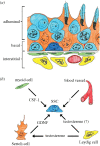Spermatogonial stem cell regulation and spermatogenesis
- PMID: 20403877
- PMCID: PMC2871929
- DOI: 10.1098/rstb.2010.0026
Spermatogonial stem cell regulation and spermatogenesis
Abstract
This article will provide an updated review of spermatogonial stem cells and their role in maintaining the spermatogenic lineage. Experimental tools used to study spermatogonial stem cells (SSCs) will be described, along with research using these tools to enhance our understanding of stem cell biology and spermatogenesis. Increased knowledge about the biology of SSCs improves our capacity to manipulate these cells for practical application. The chapter concludes with a discussion of future directions for fundamental investigation and practical applications of SSCs.
Figures





References
-
- Anderson R., Schaible K., Heasman J., Wylie C.1999Expression of the homophilic adhesion molecule, Ep-CAM, in the mammalian germ line. J. Reprod. Fertil. 116, 379–384 - PubMed
-
- Antonangeli F., Giampietri C., Petrungaro S., Filippini A., Ziparo E.2009Expression profile of a 400-bp Stra8 promoter region during spermatogenesis. Microsc. Res. Tech. 72, 816–822 - PubMed
-
- Arregui L., Rathi R., Megee S. O., Honaramooz A., Gomendio M., Roldan E. R., Dobrinski I.2008Xenografting of sheep testis tissue and isolated cells as a model for preservation of genetic material from endangered ungulates. Reproduction 136, 85–93 (doi:10.1530/REP-07-0433) - DOI - PubMed
-
- Ballow D., Meistrich M. L., Matzuk M., Rajkovic A.2006aSohlh1 is essential for spermatogonial differentiation. Dev. Biol. 294, 161–167 (doi:10.1016/j.ydbio.2006.02.027) - DOI - PubMed
-
- Ballow D. J., Xin Y., Choi Y., Pangas S. A., Rajkovic A.2006bSohlh2 is a germ cell-specific bHLH transcription factor. Gene Expr. Patterns 6, 1014–1018 (doi:10.1016/j.modgep.2006.04.007) - DOI - PubMed
Publication types
MeSH terms
Grants and funding
LinkOut - more resources
Full Text Sources
Other Literature Sources
Medical
